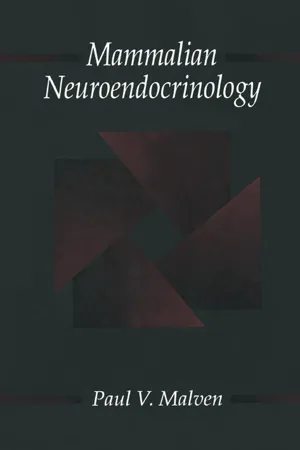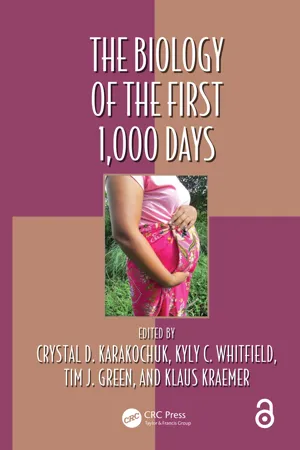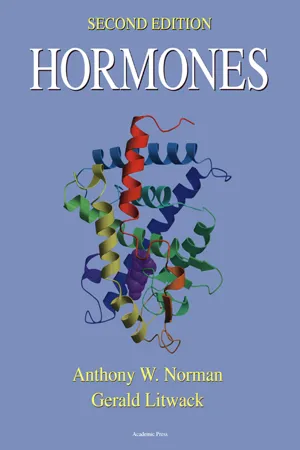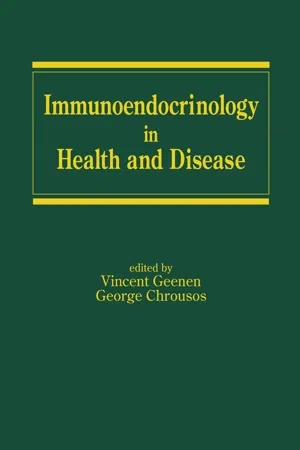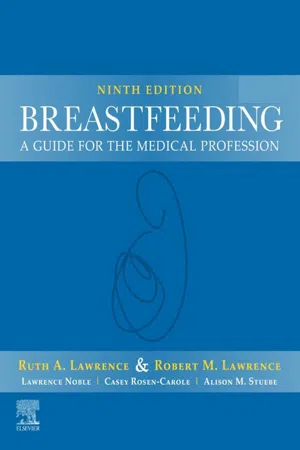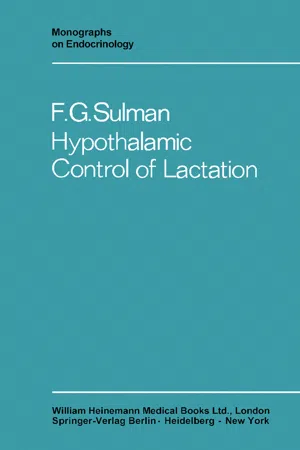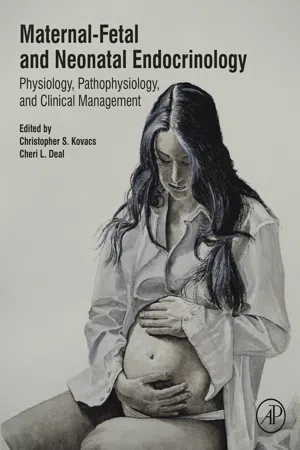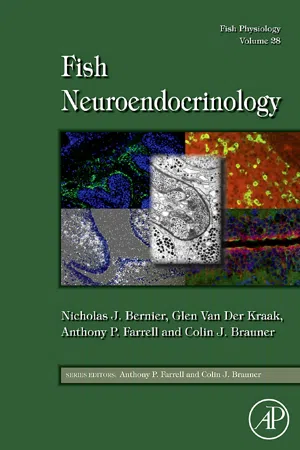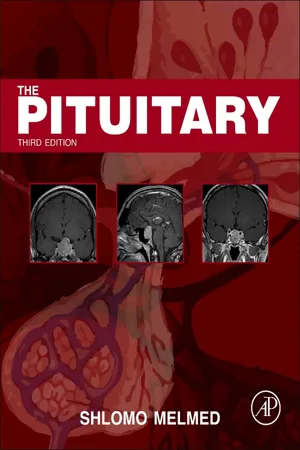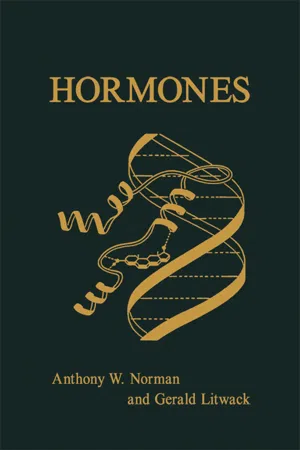Biological Sciences
Prolactin
Prolactin is a hormone produced by the pituitary gland that plays a key role in lactation and breast development in females. It also has various effects on the immune system, metabolism, and behavior. Prolactin levels are regulated by multiple factors, including stress, sleep, and dopamine. Imbalances in prolactin levels can lead to reproductive and metabolic disorders.
Written by Perlego with AI-assistance
Related key terms
Related key terms
1 of 4
Related key terms
1 of 3
12 Key excerpts on "Prolactin"
- eBook - ePub
Yen & Jaffe's Reproductive Endocrinology E-Book
Physiology, Pathophysiology, and Clinical Management
- Antonio R. Gargiulo, Jerome F. Strauss, Robert L. Barbieri(Authors)
- 2017(Publication Date)
- Elsevier(Publisher)
Chapter 3Prolactin and Its Role in Human Reproduction
Nicholas A. Tritos Anne KlibanskiProlactin (PRL) is a single chain (23-kDa) polypeptide hormone that is secreted by anterior pituitary lactotroph cells.1 Several lines of evidence indicate that PRL has an essential role in reproduction and lactation.2 In addition, animal data have supported a role for PRL in a variety of metabolic processes.2 However, such PRL actions have not been unequivocally confirmed in humans. The present chapter reviews PRL physiology, followed by a discussion of the role of PRL in pathologic states, including hyperProlactinemia and PRL deficiency. Data on the epidemiology, pathology, clinical evaluation, and management of PRL-secreting pituitary adenomas (Prolactinomas) are then reviewed, including data relevant to Prolactinomas in the setting of preconception and pregnancy.Lactotroph Development
◆ Lactotroph cells develop under carefully orchestrated control by several transcription factors. ◆ Lactotroph hyperplasia is physiologic during pregnancy and is reversible postpartum.Pituitary lactotrophs are relatively abundant in the human anterior pituitary gland, accounting for up to 25% of cells in individuals of both genders.3 During embryogenesis, the pituitary gland develops from ectodermal primordial cells, destined to form the anterior and intermediate lobe and neuroectodermal tissue arising from the floor of the diencephalon, which ultimately forms the posterior lobe. During development, inductive interactions and a host of transcription factors are critical in the formation of the pituitary and differentiation into mature functioning cells.4 - 6 Transcription factors that have been implicated in pituitary ontogenesis include SIX3, HESX1, LHX3, LHX4, SOX2, SOX3, PITX2, OTX2, BMP2, BMP4, and GLI2.4 - 6 - eBook - ePub
- Paul V. Malven(Author)
- 2019(Publication Date)
- CRC Press(Publisher)
Figure 7-1 ). This glycosylation occurs at residue 31 (asparagine) in PRL from sheep, pigs, mice, and humans, but not from cattle which have an aspartate residue at position 31 (Strickland and Pierce, 1985). Within the pars anterior tissue, only a fraction of the total PRL is glycosylated (Sinha, 1992), and this proportion varies greatly among species (e.g., 8–50 %). Glycosylated PRL also occurs in blood plasma, but its biological significance is not fully understood. The glycosylated molecules have bioactivity, but it is usually less than the major nonglycosylated form (Sinha, 1992). In addition to the major 23,000 Da form of PRL, there are several other variants of the molecule that also possess bioactivity, but additional research is needed to understand the physiological relevance of the PRL variants.Biological Actions of Prolactin
Adenohypophysial PRL is a hormone that occurs across all vertebrate species, and it is involved in many different functions. Unlike other hormones of the adenohypophysis, PRL was apparently not committed early in evolution to a particular target organ or biological process. Therefore, the biological actions of PRL are diversified and highly adaptive in nature. A major function of PRL in female mammals is stimulation of milk production by the mammary gland for support of neonatal offspring. This nurturing role for PRL first appears in pigeons where the PRL-stimulated crop sac produces the functional equivalent of mammalian milk for the offspring. Other actions of PRL in vertebrates modulate the processes of reproduction, osmoregulation, growth/metabolism, as well as maternal and migratory behaviors.Mammotrophic Actions of PRL. After mammary tissue has been suitably prepared by the maternal hormones of pregnancy, stimulation by PRL is required in all mammals to initiate lactogenesis (defined as copious secretion of milk). This mammary requirement for PRL has been demonstrated in vitro as well as in vivo using hypophysectomized females or those in which the secretion of PRL has been inhibited by pharmacological agents. In both types of in vivo - George H. Gass, Harold M. Kaplan(Authors)
- 2020(Publication Date)
- CRC Press(Publisher)
Table 2 ).ACTIONS OF Prolactin
The effects of Prolactin in mammals are exerted primarily on the organs of reproduction. Prolactin is also an important factor in the regulation of the immune system,99 pancreatic development,100 and metabolism.With regard to reproduction Prolactin stimulates the secretion of milk during lactation and promotes the growth of the mammary glands during pregnancy.101 , 102 , 103Prolactin can induce lactogenesis in ovariectomized, adrenalectomized, and hypophysectomized rats and mice when it is given in combination with an adrenal corticosteriod.104 , 105Prolactin induces polarity in mammary gland cells106 and the appearance of golgi vesicles which contain casein. In vitro Prolactin can induce casein synthesis,107 , 108 , 109α-lactalbumin,110 , 111 lactose, and milk fat synthesis.112 , 113In rodents, Prolactin activates the corpus luteum and acts as part of a luteotropic complex with LH to maintain corpus luteum function.114 In other species Prolactin is not a factor in the regulation of the corpus luteum, but Prolactin may be trophic to the regulation of granulosa cell function in the human ovary.115 , 116 Prolactin also acts on the testes, stimulating gonadotropin binding and increasing testosterone production.117 , 118 Prolactin acts on the prostate gland and increases prostatic secretions. Prolactin receptors have been demonstrated in the prostate gland.119 Prolactin can stimulate growth and differentiation of prostate cells in vitro.120At high concentrations, Prolactin is antigonadotropic. Prolactin has a direct inhibitory effect on the hypothalamus and prevents gonadotropin secretion.117 , 121 Studies in rodents show that Prolactin can prevent the release of gonadotropins in response to gonadectomy.122 , 123 More recently, it has been shown that Prolactin can reduce LHRH secretion from cultured LHRH cells in vitro.44 These results suggest that hyperProlactinemia can prevent hypothalamic LHRH release. Prolactin also has direct antigonadal effects. It can be luteolytic in the rat. At high levels, Prolactin reduces 20α-hydroxysteroid dehydrogenase activity in the ovary.124 , 125 These antigonadotropic effects of Prolactin occur both during lactation and in disorders of Prolactin secretion.53- eBook - ePub
- Crystal D Karakochuk, Kyly C. Whitfield, Tim J Green, Klaus Kraemer, Crystal D Karakochuk, Kyly C. Whitfield, Tim J Green, Klaus Kraemer(Authors)
- 2017(Publication Date)
- CRC Press(Publisher)
Stimulation of myoepithelial cell contractionsNotes: OT, oxytocin; PRL, Prolactin.a Effects exerted during pregnancy.The release of both PRL and OT during lactation is elicited through neuroendocrine reflex arcs that are initiated by suckling and, likely, other sensory stimuli from the offspring, and that engage complex ascending pathways into the neuroendocrine hypothalamus. These processes have been investigated in highly sophisticated animal models for many years and are the subject of detailed reviews [5 –10 ], yet our understanding of these processes remains incomplete. This chapter provides an overview of our current knowledge of the mechanisms that mediate these neuroendocrine reflexes. Although the vast majority of the experimental data have been obtained from studies in animals, it seems highly likely that the regulation of lactation in humans will follow similar principles.Actions of Prolactin (PRL)
PRL participates in multiple aspects of lactation, both in the mammary gland and in the central nervous system [2 ,3 ,9 ,11 ]. PRL is secreted from the lactotrophs (or mammotrophs) of the anterior pituitary gland, and also from a population that secretes both PRL and growth hormone (somatomammotrophs) [8 ]. The chemistry of PRL has been thoroughly reviewed elsewhere [12 ]. Briefly, native PRL is a protein of approximately 23,000 molecular weight, but PRL also circulates in a number of isoforms, for example, as phosphorylated or glycosylated monomers, as well as in multimeric species, modifications that can influence biological activity [8 ].The actions of PRL in the mammary gland to promote lactogenesis have likewise been reviewed extensively and are reasonably well understood [1 ,2 ,9 ,12 ]. The PRL receptor is a member of the cytokine superfamily. The binding of PRL occurs in a stepwise fashion across two PRL receptor monomers, which then promotes their dimerization and initiates signal transduction, mediated predominantly via Janus kinase-signal transducer and activator of transcription proteins, which are coupled to gene expression [9 ,12 ]. Mammary gland genes that are regulated by PRL encode most milk proteins, as well as enzymes that are involved in synthesis of other milk constituents (e.g., lipids) (Table 6.1 ). A current concept is that PRL, along with cortisol, supports the onset of lactogenesis II when progesterone, which inhibits milk secretion, falls after parturition and also is essential in maintaining lactation [2 ,3 ]. PRL also gains access to the brain and exerts multiple actions that support lactation, such as the initiation of maternal behavior, the stimulation of food intake, and, possibly, facilitatory effects on OT secretion [11 - eBook - ePub
- Anthony W. Norman, Gerald Litwack(Authors)
- 1997(Publication Date)
- Academic Press(Publisher)
Figure 5-16A .FIGURE 5-16 (A) Processing of the human Prolactin gene. The exons are denoted by numbers (1−5) and the introns by letters (A–D). (B) Detailed analysis of the 5’ flanking regions of the rat Prolactin gene. Abbreviations: ERE, estrogen response element; TRE, thyroid response element; 1P, 2P, 3P, and 4P refer to proximal binding sites for Pit-1; 1D, 2D, 3D, and 4D refer to distal binding sites for Pit-1.Reproduced with permission from Molitch, M. E. (1995) . Prolactin. In “The Pituitary” (S. Melmed, ed.), pp. 136−186. Blackwell Science, Oxford.The most obvious role of Prolactin is in the differentiation of the mammary gland cells and as a signal in the differentiated cells to produce milk proteins and other constituents. Prolactin may act like a secondary growth hormone, particularly on the liver. PRL also can act on the testis to stimulate the production of testosterone. It seems to have some role in stress adaptation as its release from the anterior pituitary is signaled by the release of β-endorphin in response to stress and as a consequence of the action of CRH; β-endorphin then acts, apparently directly, on the mammotrope (lactotrope) to stimulate the release of PRL. It has been known for some time that nursing an infant on demand over a long period of time creates a period in which pregnancy rarely occurs. This is apparently the result of frequent release of PRL from the anterior pituitary in response to suckling, which may have the effect of reducing GnRH release from the hypothalamus.Prolactin derives from the lactotroph of the anterior pituitary. These cells represent about 20% of pituitary cells, and this proportion is similar in males and females, suggesting a significant role for PRL in the male. PRL receptors occur in the Leydig cells of the testis and other sexual tissues. It appears that PRL maintains the level of LH receptors, which, in turn, facilitates the action of LH and maintains levels of testosterone production. There are other activities of PRL in the male. Lactotrophs synthesize PRL exclusively, but there is a minority of cells that can synthesize and secrete both PRL and GH. A DNA-binding protein named Pit-1 has been characterized that appears to activate the PRL gene. A similar factor called GHF-1 carries out an analogous function in stimulating the production of GH, and the two factors are probably identical. Knockout of the Pit-1 function decreases the expression of PRL and GH and diminishes growth in cell culture experiments. The Pit-1 message is expressed in somatotrophs, lactotrophs, and thyrotrophs. Pit-1, after transfection, will activate PRL gene expression. It is apparent that other cell-specific nuclear factors are required to generate a specific hormonal response. Like several other transcriptional activators, Pit-1 is most efficient in stimulating PRL expression when two molecules of Pit-1 interact at the DNA level. Mutations in the Pit-1 gene have been found in certain genetic strains of dwarf mice, suggesting that Pit-1 function is required for the elaboration of GH (and PRL), and presumably this will have significance for human dwarfism. - eBook - ePub
- Vincent Geenen(Author)
- 2004(Publication Date)
- CRC Press(Publisher)
7 ]. We will briefly consider the nature and the sources of lactogenic hormones: their receptors, their biochemical and molecular effects in leukocytes, their in vivo and in vitro effects on the development of the immune system and on immune responses, their possible role in hemopoietic malignancies and in tumor immunology. Signaling through the PRL-R has been covered in detail in Chapter 2. We will critically review evidence that PRL is the oldest cytokine and, more important, that it is a hemapoietic growth and differentiation factor in mammals.II. Prolactin: A FAMILY OF MOLECULES
A. Pituitary Prolactin
PRL is the prototype of lactogenic hormones. In mammals, its main actions are related to the development of the mammary gland and milk production [1 ,2 ]. Several other hormones and growth factors are involved in these processes, but only agonists acting through the PRL receptor (PRL-R or lactogenic receptor) are called lactogens. In addition to PRL, the lactogenic hormones include GH (from primates only) and placental lactogens. There is only one gene for PRL in human, mouse, and rat, mapping close to the MHC in the human (on chromosome 6, 6p22.2–p21.3). In the mouse in particular, many PRL-related proteins (PLP) are coded for by related genes, but, having no lactogenic activity, they are not considered here [2 ]. One of these, the murine PRL-like protein PLP-E, is a true hemopoietic growth factor [12 ].PRL is the most abundant pituitary hormone in humans. It is a 4-helix-bundle polypeptide with a strong homology to GH and placental lactogen and a weak homology to other cytokines such as interleukin (IL)-6. The major form of PRL is 23 kDa PRL in the human, mouse, and rat. Posttranslational modifications yield a large array of PRL variants. PRL can undergo glycosylation, phosphorylation, dimerization (big PRL), or proteolytic cleavage. Some features of PRL are summarized in Table 1. The PRL variants differ in their specific activity. Immunoreactive forms with an apparent molecular weight of 45 kDa or more in reduced gels have been detected, but in most cases compelling evidence that they are indeed products of the PRL gene was missing. High molecular weight complexes containing PRL [“big-big PRL,” consisting of PRL multimers or PRL-immunoglobulin (PRL-Ig) complexes, possibly PRL-antiPRL complexes] are also found in normal and pathological sera. In some cases, the presence of a covalent linkage between PRL and Ig has been ascertained [13 –15 ]. Big-big PRL is active in vitro (Nb2 assay) but not in vivo (due to poor crossing of the endothelial barrier). A 16 kDa N-terminal proteolytic fragment of rat PRL does not bind the PRL-R but has biological (e.g., antiangiogenic) activity [16 ,17 ]. The 6 kDa C-terminal fragment has some residual lactogenic activity [18 - eBook - ePub
Breastfeeding
A Guide for the Medical Professional
- Ruth A. Lawrence, Robert M. Lawrence(Authors)
- 2021(Publication Date)
- Elsevier(Publisher)
Fig. 3.20 ).Fig. 3.20 An overview of the regulation of Prolactin secretion. Prolactin secretion is paced by a light-entrained circadian rhythm, which is modified by environmental input, with the internal milieu and reproductive stimuli affecting the inhibitory or stimulatory elements of the hypothalamic regulatory circuit. The final common pathways of the central stimulatory and inhibitory control of Prolactin secretion are the neuroendocrine neurons producing Prolactin-inhibiting factors (PIFs) , such as dopamine (DA) , somatostatin (SST) , and γ-aminobutyric acid (GABA) , or Prolactin-releasing factors (PRFs) , such as thyrotropin-releasing hormone (TRH) , oxytocin (OT) , and neurotensin (NT) . PIFs and PRFs from the neuroendocrine neurons can be released either at the median eminence into the long portal veins or at the neurointermediate lobe, which is connected to the anterior lobe of the pituitary gland by the short portal vessels. Thus, lactotrophs are regulated by bloodborne agents of central nervous system or pituitary origin (α-melanocyte –stimulating hormone) delivered to the anterior lobe by the long or short portal veins. Lactotrophs are also influenced by PRFs and PIFs released from neighboring cells (paracrine regulation) or from the lactotrophs themselves (autocrine regulation).(From Freeman ME, Kanyicska B, Lerant A, Nagy G. Prolactin: structure, function and regulation of secretion. Physiol Rev. 2000;80:1523-1630.)Although both oxytocin and Prolactin release are stimulated by nipple stimulation, some oxytocin is released by other sensory pathways, such as visual, tactile, olfactory, and auditory.79 Thus, a woman may release milk on seeing, touching, hearing, smelling, or thinking about her infant. Prolactin, however, is released only on nipple stimulation so that milk production is not initiated by other sensory pathways. Oxytocin is also released under physical stress, such as pain, exercise, cold, heat, changes in plasma osmolality, or hypovolemia, but these responses are blunted or reversed during lactation.75 ,78 - eBook - ePub
Hypothalamic Control of Lactation
Monographs on Endocrinology
- F. G. Sulman, F. Gross, A. Labhart, T. Mann(Authors)
- 2013(Publication Date)
- Butterworth-Heinemann(Publisher)
This chapter discusses about Prolactin, which is the specific hypophysiotropin that promotes lactation in the pregnant mammal. Prolactin is distinguished from other pituitary tropins by its inhibitory regulation originating in the central nervous system, that is, the hypothalamus, by lack of a reciprocal peripheral feedback mechanism; by its diverse effects among the vertebrates, including growth-promoting actions in several species; and by its close association with growth hormone. It is probably present in the hypophysis of all vertebrates, but it is more plentiful in some species and at certain stages of the life cycle than at others. It is not soluble in any fat solvent. Prolactin-like activity in urine has been demonstrated both by pigeon crop sac assay and by observation of the effect of urine on the hormonally-primed mammary gland of the immature hypophysectomized male rat. Present evidence indicates that mainly one anterior pituitary hormone Prolactin—and perhaps also somatropin hormone (STH)—is involved in the development of the mammary gland. A most interesting development during the past few years is the growing evidence that Prolactin and STH in combination can induce full mammary lobulo-alveolar growth in the apparent absence of ovarian hormones in the rat.a) Introduction
Interest in the physiology of pituitary Prolactin greatly increased in recent years, as indicated by the large number of investigations on this subject since 1960. Prolactin is distinguished from other pituitary tropins by its inhibitory regulation originating in the central nervous system, i.e. the hypothalamus, by lack of a reciprocal peripheral feedback mechanism, by its diverse effects among the vertebrates, including growth-promoting actions in several species, and by its close association with growth hormone.b) Storage and Release
Prolactin is probably present in the hypophysis of all vertebrates (NICOLL , 1968), but it is more plentiful in some species and at certain stages of the life cycle than at others. Ox and sheep glands usually yield 30 to 40 IU per gram of fresh tissue, while pork glands contain much less. Measurements of the Prolactin content of human pituitaries indicate that the hormone accounts for about 2 percent of the acetone-dried residue of the gland. More Prolactin is contained in the adenohypophyses of goats, sheep and cows, and less in the glands of cats and rabbits. In most species the Prolactin content of the pituitary increases steadily during pregnancy, with an increase sometimes occurring soon after parturition. This is also reflected in the MTI (Fig. 10 - eBook - ePub
Maternal-Fetal and Neonatal Endocrinology
Physiology, Pathophysiology, and Clinical Management
- Christopher S. Kovacs, Cheri Deal, Cheri L. Deal(Authors)
- 2019(Publication Date)
- Academic Press(Publisher)
1214.2.3 Other Endocrine Requirements for LI
Glucocorticoids facilitate epithelial growth and differentiation during pregnancy and LI.30 After binding their ligands, cytoplasmic glucocorticoid receptors (GRs) enter the nucleus to bind target response elements in the promoters of various milk protein genes to increase their transcription in concert with the actions of PRL.30 Similar responses have been described during the differentiation of human breast epithelium in vitro.31 In vitro studies also emphasize that insulin, in combination with GC and PRL, is essential for the synthesis of specific milk proteins during LI.32 Recent experiments in mice support the notion that insulin, acting directly on epithelial cells through its receptor A and B isoforms, stimulates the mammary epithelium to proliferate and to enter LI.33 However, the role of insulin, as well as the insulinlike growth factors, in modulating human breast growth and differentiation during pregnancy remains an important yet unresolved question.14.3 The colostral phase
During the first 24 h postpartum, the newborn consumes small volumes of colostrum (1–5 mL per feed) over 8–12 feedings.34 – 36 The lactose content of colostrum (around 5.1%) is lower than in mature milk, whereas its sodium content is higher. The fat content varies from 1.5% to 3% and includes fatty acids synthesized by the epithelium de novo. The protein content of colostrum is around 2%, including an abundance of IgA.31 , 37 Despite the small volumes involved, these early, small feedings are also rich in a range of bioactive and immunomodulatory proteins, including a diversity of oligosaccharides required for maturation of the infant gut and immune system.38 While there are no rapid changes in the concentrations of lactose or sodium in the maternal blood, urine, or milk in the first 24 h postpartum, there are increases in the transcriptional activity of the mammary epithelium.39 – 41 By 24 h postpartum, the transcription of genes responsible for fatty acid and lipid transport and the de novo synthesis, packaging, and secretion of milk fat, as well as galactose synthesis and transport to the Golgi, is increased.39 - eBook - ePub
- Nicholas J. Bernier, Glen Van Der Kraak, Anthony Farrell, Colin Brauner(Authors)
- 2009(Publication Date)
- Academic Press(Publisher)
Chapter 5 The Neuroendocrine Regulation of Prolactin and Somatolactin Secretion in Fish
Hiroshi Kawauchi, Stacia A. Sower and Shunsuke Moriyama
Abstract
This chapter describes the neuroendocrine control of synthesis and secretion of two homologous pituitary hormones, Prolactin (PRL) and somatolactin (SL), in teleost fish. PRL and SL are produced in the rostral pars distalis and the pars intermedia of Osteichthyes, respectively. The synthesis and secretion of PRL and SL are regulated by two antagonistic hypothalamic neurohormones. Specific action of each hypothalamic neurohormone is determined by the presence of specific G‐protein coupled receptors. Both PRL and SL have been implicated in many physiological processes through specific Janus kinase (JAK) associated receptors. The molecular characteristics and biological functions of these hormones and their receptors are summarized briefly and mode of actions of hypothalamic stimulating and inhibiting factors, including some of our recent findings on PRL‐releasing peptide (PrRP), are discussed.1. Introduction
Prolactin (PRL) and somatolactin (SL) along with growth hormone (GH) form a family of pituitary hormones that belong to the class I helical cytokines superfamily. All members of this superfamily share a similar three‐dimensional fold into a bundle of four α‐helices, signal via related receptors and activate a similar intracellular signaling cascade (Huising et al. , 2006). PRLs and GHs have been identified in many representative species from all classes of vertebrates except for PRL in the Chondrichthyes and Agnathans, while SLs have been found only within the Osteichthyes (Kawauchi et al. - eBook - ePub
- Shlomo Melmed(Author)
- 2010(Publication Date)
- Academic Press(Publisher)
J Clin Endocrinol Metab . 1990;71(1):256-259.[276] Lin S.H.. Prolactin-releasing peptide. Results Probl Cell Differ . 2008;46:57-88.[277] Enjalbert A., Bertrand P., Le Dafniet M., Epelbaum J., Hugues J.N., Kordon C., el al. Somatostatin and regulation of Prolactin secretion. Psychoneuroendocrinology . 1986;11(2):155-165.[278] Vale W., Rivier C., Brazeau P., Guillemin R.. Effects of somatostatin on the secretion of thyrotropin and Prolactin. Endocrinology . 1974;95(4):968-977.[279] Carr D., Gomez-Pan A., Weightman D.R., Roy V.C., Hall R., Besser G.M., el al. Growth hormone release inhibiting hormone: Actions on thyrotrophin and Prolactin secretion after thyrotrophinreleasing hormone. Br Med J . 1975;3(5975):67-69.[280] Knigge U.P.. Histaminergic regulation of Prolactin secretion. Dan Med Bull . 1990;37(2):109-124.[281] Knigge U., Matzen S., Warberg J.. Histaminergic stimulation of Prolactin secretion mediated via H1- or H2-receptors: Dependence on routes of administration. Neuroendocrinology . 1986;44(1):41-48.[282] Carlson H.E., Ippoliti A.F.. Cimetidine, an H2-antihistamine, stimulates Prolactin secretion in man. J Clin Endocrinol Metab . 1977;45(2):367-370.[283] Masala A., Alagna S., Faedda R., Satta A., Rovasio P.P.. Prolactin secretion in man following acute and long-term cimetidine administration. Acta Endocrinol (Copenh) . 1980;93(4):392-395.[284] Terry L.C., Martin J.B.. Evidence for alpha-adrenergic regulation of episodic growth hormone and Prolactin secretion in the undisturbed male rat. Endocrinology . 1981;108(5):1869-1873.[285] Steiner J., Cassar J., Mashiter K., Dawes I., Fraser T.R., Breckenridge A.. Effects of methyldopa on Prolactin and growth hormone. Br Med J . 1976;1(6019):1186-1188.[286] Slater S.L., Lipper S., Shiling D.J., Murphy D.L.. Elevation of plasma-Prolactin by monoamine-oxidase inhibitors. Lancet . 1977;2(8032):275-276.[287] Onali P., Eva C., Olianas M.C., Schwartz J.P., Costa E.. In GH3 pituitary cells, acetylcholine and vasoactive intestinal peptide antagonistically modulate adenylate cyclase, cyclic AMP content, and Prolactin secretion. Mol Pharmacol - eBook - ePub
- Anthony W. Norman, Gerald Litwack(Authors)
- 2014(Publication Date)
- Academic Press(Publisher)
Fig. 5-9B ). Furthermore, C. H. Li’s laboratory has shown that the β subunits alone of hCG and LH have steroidogenic activity.Figure 5-20 How anterior pituitary hormones which share a similar subunit (TSH, FSH, LH) specify receptors on different cell types.V Prolactin
The most obvious role of Prolactin is in the differentiation of the mammary gland cells and as a signal in the differentiated cells to produce milk proteins and other constituents. Prolactin may act like a secondary growth hormone, particularly on the liver, although this is not well understood. PRL also can act on the testis to stimulate the production of testosterone. It seems to have some role in stress adaptation as its release from the anterior pituitary is signaled, in this case, by the release of β-endorphin in response to stress and as a consequence of the action of CRH; β-endorphin then acts, apparently directly, on the mammotrope (lactotrope) to stimulate the release of PRL. It has been known for some time that nursing an infant on demand over a long period of time creates a period in which pregnancy rarely occurs. This is apparently the result of frequent release of PRL from the anterior pituitary in response to suckling which may have the effect of reducing GnRH release from the hypothalamus.A Inhibition of Prolactin Release
Inhibition of Prolactin release by drugs is discussed in Chapter 14 in connection with lactation.PIF, the endogenous inhibitor of PRL release, appears to be dopamine. Apparently, the dopamine may derive from the posterior pituitary rather than from the hypothalamus, which is typical of the releasing hormones. Posterior pituitary extracts contain high levels of dopamine. When the posterior pituitary is removed, there is a prompt and significant increase in the level of circulating Prolactin. This is reversible specifically by dopamine. Thus, posterior pituitary dopamine (from a dopaminergic neuron?; see Fig. 5-21
Index pages curate the most relevant extracts from our library of academic textbooks. They’ve been created using an in-house natural language model (NLM), each adding context and meaning to key research topics.
Explore more topic indexes
Explore more topic indexes
1 of 6
Explore more topic indexes
1 of 4

